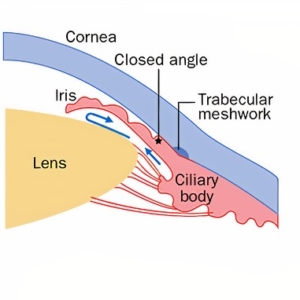(Originally posted at USC Roski.)

High eye pressure, also known as elevated intraocular pressure, is an important risk factor for developing glaucoma. However, it is common for patients to develop glaucoma even with normal eye pressure.
By Eric Weintraub
Vanessa Ho was just beginning her Saturday morning when she suddenly felt intense pain and blurry vision in her right eye. She had experienced these symptoms once before when she suffered an acute angle closure attack – a condition that causes rapid buildup of high eye pressure – in her left eye. She knew that if left untreated, the attack would lead to glaucoma and permanent vision loss. Frightened and desperate to seek treatment, Vanessa called the USC Roski Eye Institute to reach the ophthalmologist she had recently begun to see, Dr. Benjamin Xu.
Dr. Xu returned her call within minutes and requested that she come into the clinic immediately. Vanessa’s husband drove her to the Roski Eye Institute where Dr. Xu used a laser to make a small hole in her iris (a procedure known as a laser peripheral iridotomy) to break the acute attack and relieve the pressure buildup in her eye. The procedure proved successful, and by that evening, Vanessa’s eyesight was restored.
“Think of the eyeball like a sink,” Dr. Xu said, describing how an acute angle closure attack affects the eye. “There’s a faucet that’s always producing fluid, and there’s a drain. The drain is located in the angle, where the iris meets the cornea. Angle closure blocks the normal flow of fluid through the drain and out of the eye, which causes eye pressure to go up. This can either happen slowly, which leads to chronic angle closure, or suddenly, which leads to acute angle closure. Either way, high eye pressure can damage the optic nerve, leading to glaucoma and permanent vision loss.”
While the laser treatment proved a temporary fix to restore Vanessa’s eyesight, she continued to see Dr. Xu and eventually underwent cataract surgery, which provides a permanent solution to angle closure and eliminates risk of angle closure glaucoma.
“Dr. Xu treated me with passion and confidence, from his tone of voice to his mannerisms, and from his caring to his knowledge about the closed angle glaucoma,” Vanessa said. “I initially came to Dr. Xu in tears about being blind, but left his office every time with the biggest smile. I’d like to let other patients know that Dr. Xu is the best glaucoma doctor in the whole Los Angeles area.”

In angle closure, the iris is pushed or pulled forward into the trabecular meshwork. This blocks the eye’s drain, and aqueous humor is trapped inside the eye. This can lead to high intraocular pressure, a strong risk factor for glaucoma.
When Dr. Xu is not taking care of his patients, he leads a National Institutes of Health (NIH)-funded research laboratory that focuses on improving the care of patients with angle closure glaucoma. “While angle closure glaucoma is the second most common form of glaucoma, it is the most visually devastating form because it causes very high eye pressure,” he said. “It’s essential to research this disease because at-risk patients often go unnoticed by their eye doctors. It’s the type of condition that you won’t find if you don’t look for it.”
Dr. Xu’s research group is developing new clinical tools to assist ophthalmologists in catching angle closure earlier, so that acute attacks like the one Vanessa experienced may one day be an affliction of the past. The Xu lab combines optical coherence tomography (OCT), an advanced and non-invasive form of eye imaging, with artificial intelligence, a powerful tool for analyzing data, to develop automated devices for detecting patients at risk for angle closure glaucoma. These devices could one day serve as a replacement for gonioscopy, a contact lens that is the current standard for eyecare providers to detect angle closure.
The Xu lab is also currently using Big Data, an electronic database generated by millions of Americans visiting the doctor’s office, to clarify the impact of angle closure glaucoma in the U.S. “There have been few studies on angle closure glaucoma in the U.S. which has led to an underestimation of its impact on patients” said Dr. Xu. “Our results suggest that angle closure glaucoma is not only common in Asian-Americans, but Hispanics and African-Americans as well. We’re working hard to raise awareness for people who are most vulnerable to the disease.”
Dr. Xu collaborates with researchers from around the world to find new solutions to prevent more people from developing angle closure glaucoma. Vanessa’s story serves as a perfect example for why the research is so vital. “Patient awareness, early detection, and prompt treatment are the best tools we have to save people from angle closure glaucoma and permanent vision loss.”
